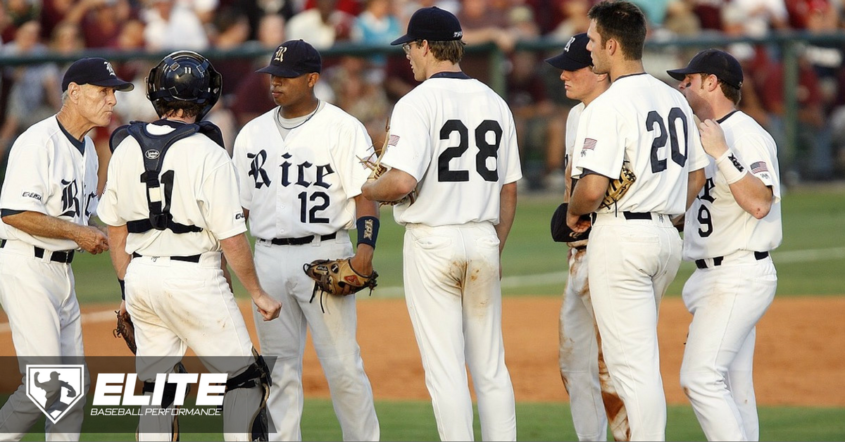The Thought Process of a Big Game Pitcher
Why does one pitcher succeed with below-average velocity and “stuff,” while another who throws 96-98mph posts a 7.00 ERA?
Why do flame-throwing rookies have such a hard time getting outs, despite amazing ability? Regardless of how hard a pitcher throws, he must learn how to read hitters, execute pitches, and process all the information he’s given on every swing a hitter takes.
In this article, you’ll learn the process of big-game pitchers, the guys who teams trust when the game is on the line. Becoming an Ace takes a lot of mental bandwidth, and I’ll give you an outline below to help expand yours.
The Four-Zone Process
Between at-bats, we need to remind ourselves all our duties before and after the pitch. Within this checklist are simple things like knowing the score and which base we’ll back up on a double.
But, there are higher-level processes like analyzing the hitter, the situation, our own strengths and weaknesses, and how it all fits together when we choose the next pitch.
In short, smart pitchers are much like computers. The more experience one has – both playing the game and going through a logical, analytical process – the faster one can process larger amounts of information.
The faster you process the simple pieces, the more bandwidth you free up to think clearly about the reason you’re choosing the next pitch. And, you MUST have a reason behind every pitch you throw.
Zone 1: The Big Picture
In this zone, we’re standing in the grass behind the mound. We just retrieved the ball following the conclusion of an at-bat, and we’re taking it all in to prepare for the next one.
We think about the big things, such as the score, the inning, base runners (where and who they are), what base to cover on a single or extra-base hit to different parts of the park, where to go with a comebacker or bunt, and the overall situation. What needs to happen next for us?
Zone 2: Focus on the Hitter and Runner, and situation
In this zone, we’re standing at the bottom of the mound, narrowing our focus from the big picture and more custodial tasks (like which bases we cover).
We narrow our focus and think about the hitter and the baserunners – what threats they present and how we’ll deal with them.
The first focus can be who’s up, and what has he done thus far? 0-2 with two Ks, or 2-3 with two doubles? What do we know about his habits, swing, etc.? What’s the situation ask him to do? Bunt? Swing away? Hit behind the runner?
What’s he capable of? Can he hurt us? What can’t he do? How did we pitch him last time? What’s his swing look like? What do we see? What’s his approach?
The next focus could be who is on base? Is it a stealing situation? Is there a base open? If so, will that change how you pitch the hitter?
How fast are the base runners? Is the lead runner a stealing threat?
How aggressive have you seen the baserunners lead, steal or break on balls in the dirt? Do we know if they like to go on a certain pitch?
Considering all the above, how much attention do they need to be paid? What do I think I might throw first pitch? Do I need to protect it if that’s the one I choose?
The last focus can be what’s the situation? What is the best possible result?
What do I need? Strikeout? Ball to stay on the infield? Do I have a base open? Is the double play in order?
Is the hitter likely to change his approach because of the situation? Am I changing my approach because of the situation? How does mine match up with his? What’s my escape route? How do I get the result I want?
Zone 3: Planning for the Pitch, At-Bat and Running Game
In Zone 3, we are straddling the rubber as the hitter completes his warm-up swings. This is our waiting position – as he gets in the box, we then step on the rubber and narrow our focus even more. What do we want the catcher to put down?
First, we summarize the hitter. What are his tendencies? What has he done?
What does his approach appear to be? Does it change as the at-bat changes?
What are his weaknesses? Does he have a swing flaw? Slow bat? Obvious bat path? Where does his bat-path live?
Next, we remind ourselves of our strengths. What are we good at? Does our strength match his weakness?
How did we pitch him last time? Did it work?
What do I feel confident in today? What do I want to stay away from?
What can I not allow him to beat me on? What is my go-to pitch when the game is on the line?
Lastly, we do some planning of the at-bat.
If I get my intended result on the first pitch, where might I go next? If I don’t, what am I probably coming back with?
How likely is it that the runner steals on the first pitch? The second?
Do I need to pick over on the first pitch? What move do I show him? A? B? C?
Am I in big trouble if this runner steals the next base? Is this a base-open situation? Do I need to throw it over the plate if I fall behind? Or, can I pitch him tough until the end?
What’s the first stepping stone to the result I want?
Zone 4: Choose your pitch and execute
We’ve done our diligence and checked off all the questions above (and probably many more).
With all the work done, we step onto the rubber and peer in to get our sign. We’ve chosen our pitch and know what we’re doing with the runner. Now, ALL the work is done, which leaves us with one thing left: Execute this pitch.
The One-Pitch Mindset: Crucial, But Difficult
One we’ve considered all possible information and chosen a pitch we believe in, it’s time to block out all potential consequences, stakes, results, AND all the stuff we were just thinking about. None of it matters once we’ve come set.
After the pitch is chosen, the pitcher has one job: lock his eyes on the mitt with tunnel vision and give 100% focus to executing the pitch.
Nothing else can come between the visual tunnel to the mitt. Not the roar of the crowd, the potential embarrassment if he lines it into the gap, not our potential release if our ERA goes up. None of it.
Our job is to execute one single pitch. Then, execute one single pitch. Then, execute one more single pitch. If we do that until our day is done, we’ll have strung together the best possible outing.
Remember this old proverb, “A Journey of a thousand miles begins with a single step”?
Pitching is the same way. One pitch at a time, then look back at the end and see what you’ve strung together, how a string of single pitches joined into an amazing outing.
The Secret Formula?
If someone out there tells you that pitching in games merely expresses your currently skill level…they’ve never stepped foot on the mound. These people think throwing is pitching, and it’s not.
You don’t learn any of this stuff until you’re on the mound, taking in the situation and thinking your way through it. You can become a darn good thrower in practice, but you don’t become a pitcher until you’re in the heat of the moment and forced to think your way through it.
And, if you don’t have a coach who is pushing you to think through the above checklist, you’ll never stick at the highest levels of baseball. Pitchers make it, throwers don’t – it’s just that simple, because at every level, hitters get smarter and there will always be guys who can turn around a 99mph fastball.
Learn How to Become the Ace of Your Staff

I designed this 13-hour, 80+ video course to pass along the lessons it took me a decade to absorb, so that younger pitchers with a passion for the game can learn faster, and climb higher.
Dan Blewett
Latest posts by Dan Blewett (see all)
- What Causes A Mental Meltdown in Baseball? - September 3, 2019
- Two Common Curveball Mistakes Pitchers Should Avoid - July 30, 2019
- Is Heavy Lifting Good For Pitchers? - July 2, 2019















Leave a Reply
Want to join the discussion?Feel free to contribute!